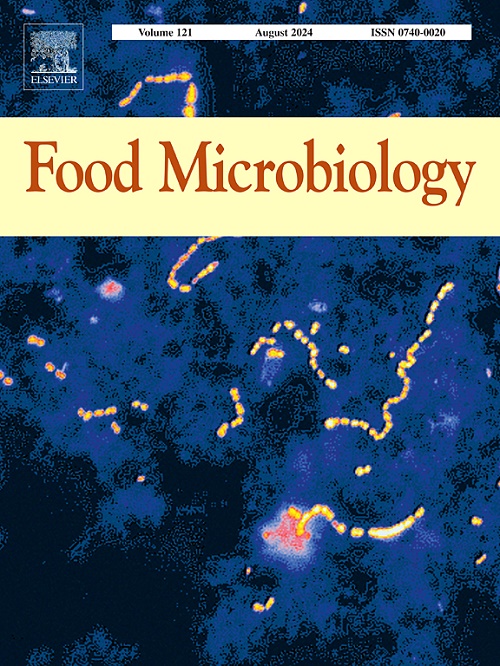A comparative study of human norovirus and human sapovirus contamination in oysters (Crassostrea gigas) tissues from physical markets and e-commerce platforms in Guangzhou, China
IF 4.5
1区 农林科学
Q1 BIOTECHNOLOGY & APPLIED MICROBIOLOGY
引用次数: 0
Abstract
Human norovirus (HuNoV) and human sapovirus (HuSaV) are the common foodborne viruses that can be transmitted through the consumption of contaminated shellfish. With the rise of e-commerce, these platforms have become an important channel for Chinese consumers to purchase seafood products. However, the potential impact of this new commercial model on viral contamination necessitates further investigation. This study aimed to compare the levels of HuNoV and HuSaV contamination in oysters (Crassostrea gigas) sourced from physical markets and e-commerce platforms. From July 2021 to June 2022, we collected oysters from both online e-commerce platform (n = 108) and offline markets (n = 108) in Guangzhou to assess HuNoV and HuSaV contamination. The HuNoV contamination rate in oysters from offline markets (61.1%) was found to be higher than that from online e-commerce platforms (54.6%) (p > 0.05). The contamination rate of HuSaV was 16.7% in online e-commerce platforms and 18.5% in offline markets, with a significance level of p > 0.05. Except for the HuNoV GI contamination levels in oysters from offline platforms, which were predominantly in the range of 105 to 106 genome copies per gram (GC/g), the highest proportions of contamination for HuNoV GI (online platforms), HuNoV GII, and HuSaV in oysters were found to be in the range of 103–104 GC/g. Additionally, the prevalence of HuSaV was significantly higher in winter (p < 0.05), while the prevalence of HuNoV did not show seasonal differences. This study demonstrates the presence of HuNoV and HuSaV in oysters marketed online and offline, highlighting the high contamination rate of foodborne viruses in oysters.
中国广州实体市场和电子商务平台牡蛎组织中诺瓦克病毒和人类萨帕病毒污染的比较研究
人类诺如病毒(humov)和人类萨波病毒(HuSaV)是常见的食源性病毒,可通过食用受污染的贝类传播。随着电子商务的兴起,这些平台已经成为中国消费者购买海鲜产品的重要渠道。然而,这种新的商业模式对病毒污染的潜在影响需要进一步研究。本研究旨在比较来自实体市场和电子商务平台的牡蛎(长牡蛎)中HuNoV和HuSaV的污染水平。从2021年7月至2022年6月,我们从广州的在线电子商务平台(n = 108)和线下市场(n = 108)收集牡蛎,以评估HuNoV和HuSaV污染。线下市场生蚝(61.1%)的污染率高于线上电商平台生蚝(54.6%)(p >;0.05)。HuSaV在线上电商平台的污染率为16.7%,在线下市场的污染率为18.5%,显著性水平为p >;0.05. 除了线下平台牡蛎中HuNoV GI的污染水平主要在105 ~ 106个基因组拷贝/克(GC/g)范围内外,在线平台牡蛎中HuNoV GI、HuNoV GII和HuSaV的污染比例最高,在103 ~ 104 GC/g范围内。此外,HuSaV的患病率在冬季显著升高(p <;0.05),而HuNoV患病率无季节差异。本研究表明,在网上和线下销售的牡蛎中存在HuNoV和HuSaV,突出了牡蛎中食源性病毒的高污染率。
本文章由计算机程序翻译,如有差异,请以英文原文为准。
求助全文
约1分钟内获得全文
求助全文
来源期刊

Food microbiology
工程技术-生物工程与应用微生物
CiteScore
11.30
自引率
3.80%
发文量
179
审稿时长
44 days
期刊介绍:
Food Microbiology publishes original research articles, short communications, review papers, letters, news items and book reviews dealing with all aspects of the microbiology of foods. The editors aim to publish manuscripts of the highest quality which are both relevant and applicable to the broad field covered by the journal. Studies must be novel, have a clear connection to food microbiology, and be of general interest to the international community of food microbiologists. The editors make every effort to ensure rapid and fair reviews, resulting in timely publication of accepted manuscripts.
 求助内容:
求助内容: 应助结果提醒方式:
应助结果提醒方式:


